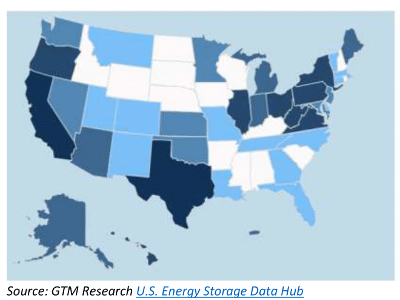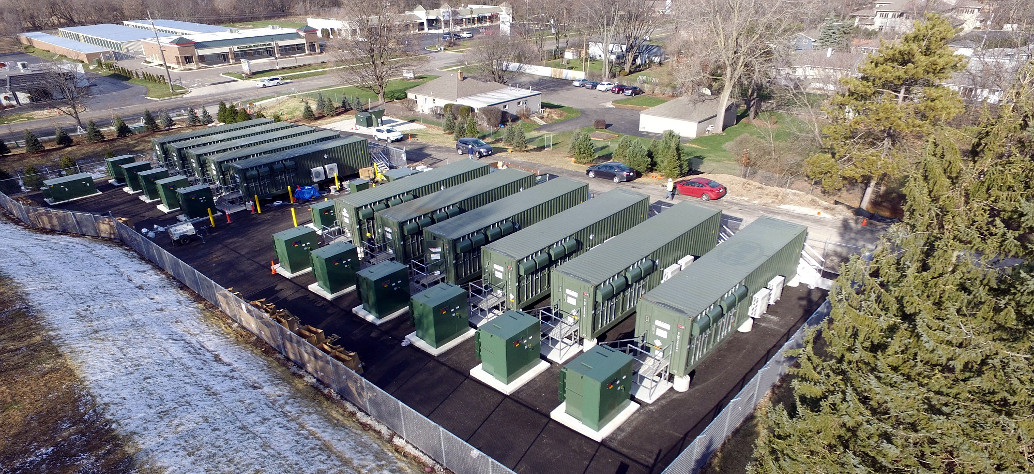Energy storage markets in the United States are moving quickly. While record Q4 deployments in California to meet reliability needs following the Aliso Canyon gas leak have caught a lot of attention, a trend which may be more meaningful in the long run is the increasing geographical diversification of energy storage deployment.
Today GTM Research reported that 21 states have at least 20 MW of energy storage projects proposed, under construction and/or already in the ground, a wide-ranging metric that includes a number of projects that may not have gotten farther than applying for an ISO interconnection agreement. The number drops to 11 states when only projects under construction or online or included, but GTM Research also notes that ten U.S. states have pipelines of over 100 MW.
 All in all, GTM Research is tracking over 10 GW of front-of-the-meter storage projects, and says that after California, Texas, Hawaii, Ohio and Illinois are the top markets. GTM Research Senior Analyst – Energy Storage Daniel Finn-Foley estimates that 150 MW of energy storage projects are currently under construction across the nation, following the installation of a record 141 MW of grid-tied storage – almost all lithium ion batteries – during the fourth quarter of last year.
All in all, GTM Research is tracking over 10 GW of front-of-the-meter storage projects, and says that after California, Texas, Hawaii, Ohio and Illinois are the top markets. GTM Research Senior Analyst – Energy Storage Daniel Finn-Foley estimates that 150 MW of energy storage projects are currently under construction across the nation, following the installation of a record 141 MW of grid-tied storage – almost all lithium ion batteries – during the fourth quarter of last year.
Finn-Foley notes that while there are mandates to deploy energy storage underway in three U.S. states, much of the recent activity coming via voluntary procurement by utilities. “You are seeing a great diversity of utilities that are looking at energy storage as a solution to some of their problems,” Finn-Foley told pv magazine.
Foley also notes the importance of the notice of proposed rulemaking (NOPR) underway at the Federal Energy Regulatory Commission (FERC), which he says could make the rules more clear for energy storage.
“There are a lot of broad agreements that the wholesale market rules should be fair for energy storage,” notes Finn-Foley. “There is a gap between what the ISOs say and what the industry is looking for.”
Among the changes Finn-Foley expects from the NOPR are measure to allow energy storage to be eligible for any services that they are technically capable of providing, and for bidding parameters to be reflect the physical and operational characteristics of energy storage.
FERC is currently in a less-than-operational state, with insufficient members to create a quorum, and is waiting on the Trump Administration to fill the Republican seats. But despite Trump’s statements regarding renewable energy, Finn-Foley expects the NOPR to “fly below the radar”.
“Energy storage doesn’t ruffle a lot of feathers,” he observes. “If FERC gets a couple of new commissioners, I don’t see them voicing any significant opposition to this.”
This content is protected by copyright and may not be reused. If you want to cooperate with us and would like to reuse some of our content, please contact: editors@pv-magazine.com.









By submitting this form you agree to pv magazine using your data for the purposes of publishing your comment.
Your personal data will only be disclosed or otherwise transmitted to third parties for the purposes of spam filtering or if this is necessary for technical maintenance of the website. Any other transfer to third parties will not take place unless this is justified on the basis of applicable data protection regulations or if pv magazine is legally obliged to do so.
You may revoke this consent at any time with effect for the future, in which case your personal data will be deleted immediately. Otherwise, your data will be deleted if pv magazine has processed your request or the purpose of data storage is fulfilled.
Further information on data privacy can be found in our Data Protection Policy.